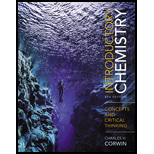
Concept explainers
(a)
Interpretation:
The symbol for the metric unit, petameter is to be stated.
Concept introduction:
The metric system unit is the unit system which is accepted as the standard system of unit internationally. There are four metric basic units, liter (
(b)
Interpretation:
The symbol for the metric unit, gigagram is to be stated.
Concept introduction:
The metric system unit is the unit system which is accepted as the standard system of unit internationally. There are four metric basic units, liter (
(c)
Interpretation:
The symbol for the metric unit, femtoliter is to be stated.
Concept introduction:
The metric system unit is the unit system which is accepted as the standard system of unit internationally. There are four metric basic units, liter (
(d)
Interpretation:
The symbol for the metric unit, nanosecond is to be stated.
Concept introduction:
The metric system unit is the unit system which is accepted as the standard system of unit internationally. There are four metric basic units, liter (
Want to see the full answer?
Check out a sample textbook solution
Chapter 2 Solutions
Introductory Chemistry: Concepts and Critical Thinking Plus MasteringChemistry with eText -- Access Card Package
- Calculate the volume of 125g of the following liquids: a. Acetone (d=0.792g/mL) b. Olive oil (d=0.918g/mL) c. Chloroform (d=1.49g/mL)arrow_forwardReferring to Table 1.3, answer the following questions: a. Which is longer, a centimeter or an inch? b. How many milliliters are in a quart? c. How many grams are in an ounce?arrow_forwardTwo cities in Germany are located 25km apart. What is the distance in miles?arrow_forward
- Calculate the volume of 125g of the following liquids: a. Sea water (d=1.03g/mL) b. Methyl alcohol (d=0.792g/mL) c. Concentrated sulfuric acid (d=1.84g/mL)arrow_forwardWhat is the SI unit of volume? What is the other common unit which in notan SI unit of volume.arrow_forwardthe volume reading on the burethra, with the correct number of digits is?arrow_forward
- Calculate the volume in liters of mercury(I) chloride solution that contains of mercury(I) chloride. What is the answer round your answer to 3 significant digits.arrow_forwardCookbooks are going metric. In such books, 1 cup is equal to 240mL. Express 1 cup in terms of liters and cubic centimeters.arrow_forward
 Chemistry for Today: General, Organic, and Bioche...ChemistryISBN:9781305960060Author:Spencer L. Seager, Michael R. Slabaugh, Maren S. HansenPublisher:Cengage Learning
Chemistry for Today: General, Organic, and Bioche...ChemistryISBN:9781305960060Author:Spencer L. Seager, Michael R. Slabaugh, Maren S. HansenPublisher:Cengage Learning World of Chemistry, 3rd editionChemistryISBN:9781133109655Author:Steven S. Zumdahl, Susan L. Zumdahl, Donald J. DeCostePublisher:Brooks / Cole / Cengage Learning
World of Chemistry, 3rd editionChemistryISBN:9781133109655Author:Steven S. Zumdahl, Susan L. Zumdahl, Donald J. DeCostePublisher:Brooks / Cole / Cengage Learning

